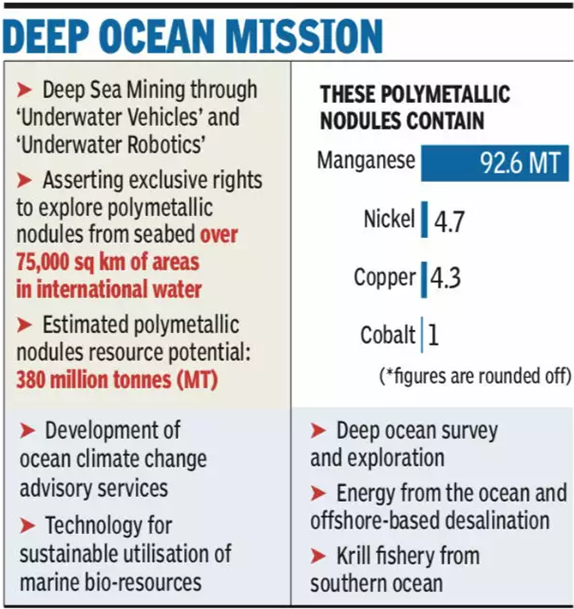Thursday, 19th January 2023
ASER Report 2022 - Edukemy Current Affairs
In News: Recently, Pratham’s Annual Survey of Education Report (ASER) 2022 was released which is the first full-fledged one after the pandemic.
About the News:
- The report highlights the national-level decline in school children’s basic reading ability besides a dip in arithmetic abilities,
- The report is based on a survey of nearly 6.99 lakh children aged 3 to 16 across 616 rural districts confirming the ‘learning losses believed to have set in amid school closures.
What is ASER?
- The Annual Status of Education Report (ASER) is a survey that aims to provide reliable annual estimates of children's enrolment, attendance, and learning levels in India.
- It has been conducted every year since 2005 in almost all rural districts of India by PRATHAM, an Indian non-profit organization working to improve the quality of education in India.
- It is the largest citizen-led survey in India, with over 600,000 volunteers participating in the survey each year.
- The survey aims to assess the basic reading and arithmetic skills of children between the ages of 3 and 16 and to provide a detailed picture of the state of education in rural India.
- It is also the only annual source of information on children’s learning outcomes in India today.
- ASER findings are used by government and non-government organizations to identify areas of improvement and to design and implement effective interventions in the field of education.
Major findings of the report:
- The basic reading ability of children in age group 5–16-year-olds enrolled in both government and private schools across the country have sharply dropped amid Covid-19 pandemic.
- Despite the prolonged closure of schools, the overall enrolment in schools across the country has increased at all levels, with 4% in the age group of 6-14 years currently enrolled in schools.
- The proportion of children (age 6 to 14) enrolled in government schools increased sharply from 65.6% in 2018 to 72.9% in 2022. Increase in government school enrolment is visible
- There is a decrease in the percentage of out-of-school girls across the country, and a sharp increase of 7.1 percentage points in the number of children enrolled in pre-primary age groups in 2022.
- The percentage of class third students in government and private schools who can read at class second level dropped from 27.3% in 2018 to 20.5%.
- As per findings, Children’s ability to read simple English sentences was at 24.7% in 2016 and is found at 24.5% in 2022.
- In the case of class fifth students, the proportion of children who could read at least class 2-level text fell from 50.5% in 2018 to 8%.
- This decline was visible in every state, with states showing a decline of more than 10 percentage points from 2018 levels including those that had higher reading levels in 2018 namely Kerala, Himachal Pradesh, Haryana, Andhra Pradesh, Telangana.
- The average teacher attendance increased from 85.4% in 2018 to 87.1%, while average student attendance persists at 72% as before.
- Textbooks had been distributed to all grades in 1% of primary schools and in 84.4% of upper primary schools.
- Fraction of schools with usable girls’ toilets increased from 66.4% in 2018 to 68.4% in 2022.
- There were 76% schools with drinking water facilities compared with 74.85% in 2018, but there are interstate variations.
- Nearly 9% schools had a playground which is slightly up from 66.5% in 2018.
Overall, there is a nationwide decline in children’s basic arithmetic levels in comparison to 2018 levels for most grades. But the decline was less steep than in the case of basic reading.
Source:
https://www.hindustantimes.com/india-news/sharp-drop-in-basic-reading-ability-of-children-amid-pandemic-aser-report-101674031095597.html
https://indianexpress.com/article/education/aser-report-2022-live-updates-pratham-foundation-led-survey-returns-after-4-years-asercentre-org-8387838/
NGT – Green Clearance violation
In News: The National Green Tribunal (NGT) has set a deadline for remedial actions and recovering damages from the Kulda coal mine run by Mahanadi Coalfields Limited (MCL) in Odisha and the Tamnar thermal plant operated by Jindal Power Limited (JPL) in Chhattisgarh, for transporting coal through villages in violation of environmental clearance (EC) conditions.
About Green Clearance
- Green Clearance or Environmental Clearance is the procedure to get clearance from the government for the installation and modification (amendment) of certain projects.
- It is mandatory for projects which can cause high environmental Pollution. Indian Constitution made a list of those projects under EIA Notification 2006, which includes mining, thermal power plant, infrastructure, etc.
- The main purpose is to assess the impact of the planned project on the environment and people and to try to abate/minimise the same.
The list of projects that require Environmental Clearance in India include:
- Mining, extraction of natural resources and power generation (for a specified production capacity)
- Primary mineral Processing
- Materials Production
- Materials Processing
- Manufacturing/ Fabrication
- Service Sectors
- Physical Infrastructure including Environmental Services
- Building/Construction projects/Area Development Projects and Townships
- The EIA Notification categorizes the projects into two categories, i.e. Category A and B.
- Projects falling under Category A get clearance from the Ministry of Environment, Forest and Climate Change, and
- Category B will get their clearance from the State Environmental Impact Assessment Authority.
- Laws Governing Environmental Clearance
- The Environment Protection Act is like umbrella legislation which assists the Central government in coordinating the central and State authorities relating to environmental affairs.
- Environment (Protection) Rules, 1986
- Environment Impact Assessment Notification (2006)
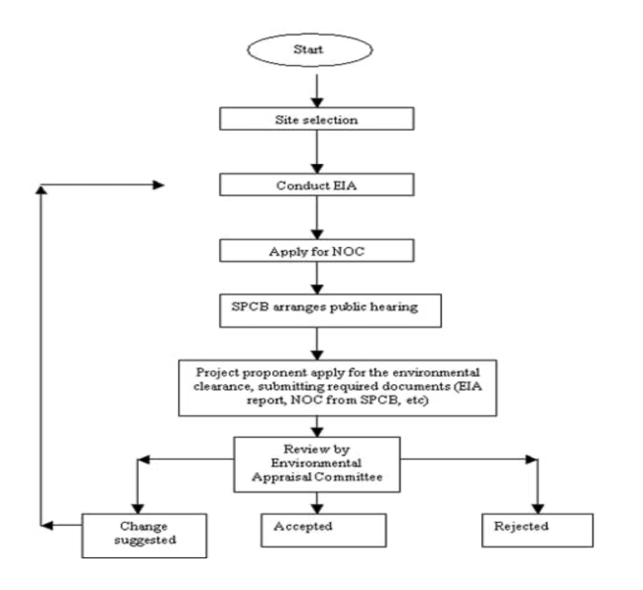 Procedure of Environmental Clearance
Procedure of Environmental Clearance
Issues associated with Green Clearance
- The Union Ministry of Environment, Forest and Climate Change (MoEFCC) has announced that it will rank the state environmental impact assessment authorities based on seven different criteria, which would exhibit their efficiency/on the speed at which environmental approvals are given. This decimates the EIA process, with undue importance to clearance.
- Lack of trained EIA professionals often leads to the preparation of inadequate and irrelevant EIA reports.
- Public comments are not considered at an early stage, which often leads to conflict at a later stage of project clearance.
- Distorted focus of EIA, needs to shift from utilization and exploitation of natural resources to conservation of natural resources.
Source:
Cost of green clearance violations: Recalling 3 cases opened by NGT
Image source:
https://www.cseindia.org/environmental-clearance---the-process-403
Loan Loss Provision – RBI New Approach
In News: The Reserve Bank of India (RBI) has published a discussion paper on “loan loss provision”, proposing a framework for adopting an expected loss (EL)-based approach for provisioning by banks in case of loan defaults.
About the new approach
- The RBI defines a loan loss provision as an expense that banks set aside for defaulted loans, which the banks can use in event of a loss, instead of taking a loss in its cash flows.
- The RBI’s proposal is based on the premise that the present “incurred loss”-based approach for the provision by banks is inadequate, and hence the need for a new regime to reduce systemic issues.
- Under this practice, a bank is required to estimate expected credit losses based on forward-looking estimations.
Issues related to the current approach:
- Higher Level of Provisioning: When Banks Face a systemic increase in defaults, the delay in recognizing loan losses results in banks having to make higher levels of provisions, which eat into the capital maintained precisely at a time when banks need to increase their capital.
- Delays in recognizing loan losses: It overstated the income generated by the banks which, coupled with dividend payouts, impacted their capital base because of reduced internal accruals.
Benefits of the new approach include:
- Enhance the resilience of the banking system.
- Result in excess provisions as compared to a shortfall in provisions
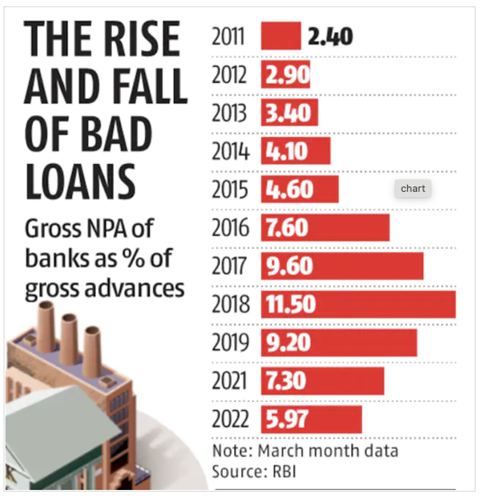 Loan Loss in India
Loan Loss in India
- In 2022, the Indian Finance Minister told Parliament that banks had written off bad loans worth ₹10,09,511 crore during the last five financial years.
- A bad loan is one that has not been ‘serviced’ for a certain period. Servicing a loan is paying back the interest and a small part of the principal — depending on the agreement between the bank and borrower.
- Also, according to recent figures put out by the RBI, the Gross non-performing assets (NPAs) of the Indian banks had crossed the Rs.8,50,000 crore mark.
- Reasons for high NPAs include credit decisions, poor monitoring, laxity in vigilance, connivance of bank employees, poor understanding of project costs as well as routine business downturns.
- Measures taken to address the issues include
- National Asset Reconstruction Company Ltd. (NARCL) in 2021-2022 to resolve stressed loans amounting to about ₹2 lakh crore in phases.
- Insolvency and Bankruptcy Code (2016)
- Asset Quality Review (2015)
- Strategic Debt Restructuring (SDR) – 2015
- Mission Indradhanush (2015)
Source:
Loan loss provision by banks: Why has RBI proposed a new forward-looking approach?
Image source:
https://www.business-standard.com/article/economy-policy/banking-sector-s-gross-npa-falls-below-6-lowest-in-six-years-122061601135_1.html
DELHI: Battle For the Face of the nation
In News
Center requested to refer the case of dispute between the Delhi government and the Centre over the control of administrative services, to a seven-judge bench, which was being heard by a five-judge Constitution Bench of the Supreme Court (SC).
About the news:
There has been a long standing tussle between NCT and Centre over the control of administrative services
Timeline of the tussle:
- 2017 – Delhi High Court’s Judgment:
- For the administration purposes of the NCT, the Lieutenant Governor (L-G) is not bound by the aid and advice of the Council of Ministers in every matter.
- 2018 – SC’s Judgment:
- A five-judge Constitution bench unanimously held that the L-G of Delhi is bound by the aid and advice of the elected government.
- 2019 – SC’s Judgment:
- A two-judge Bench of SC delivered a split verdict and referred the matter to a three-judge Bench.
- 2022 – Case:
- The Centre argued that it needed the power to make transfers and postings of officers in Delhi on account of it being the national capital and the “face of nation”.
- The Centre sought reference to a larger bench.
- The court agreed upon the need for an authoritative pronouncement by a Constitution Bench in terms of Article 145(3) of the Constitution.

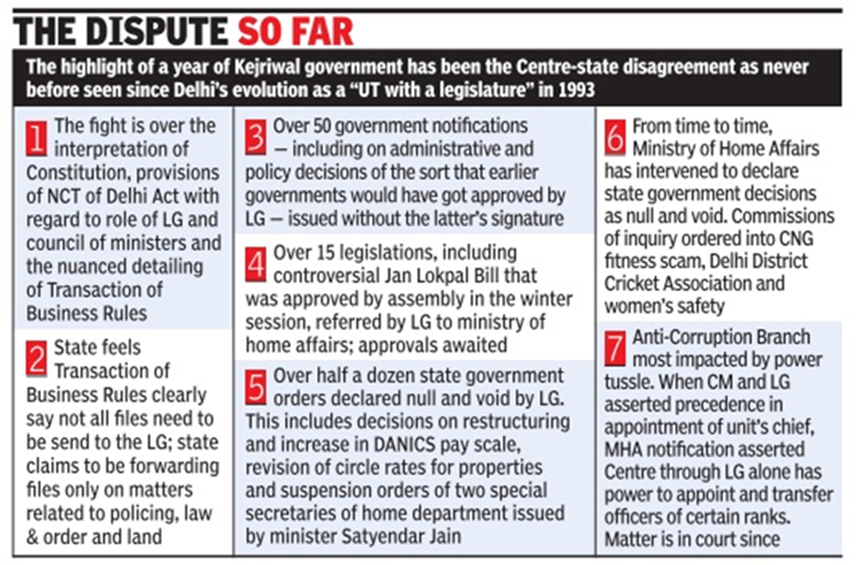
What is the Constitutional basis for the tussle between Centre and Government of NCT?
- In the 2022 case, the three-judge Bench of the SC noted that the primary contention between Centre and Delhi Government is related to the interpretation of Article 239 AA(3)(a) of the Constitution, and referred this case to a larger Bench on the Centre’s plea for “further examination”.
- Article 239 AA was inserted in the Constitution by the 69th Amendment Act, 1991, and conferred Special Status upon Delhi.
- This came as a result of the recommendations of the S Balakrishnan Committee, which was set up in 1987 to look into Delhi’s demands for statehood. The NCT of Delhi was to have an Administrator and a Legislative Assembly.
- The Legislative Assembly could make laws for the whole or any part of the NCT with respect to any matters in the State List or Concurrent List except on the subjects of police, public order, and land.
- Further, the Article 239AA also noted that L-G has to either act on the aid and advice of the Council of Ministers, or he is bound to implement the decision taken by the President on a reference being made by him.
- Also, Article 239AA, empowered the L-G to refer a difference of opinion on ‘any matter’ with the Council of Ministers to the President.
- Thus, this dual control between L-G and the elected government has led to a power tussle.
Source:
https://www.thehindu.com/news/national/at-fag-end-of-sc-hearing-of-union-versus-delhi-govt-tussle-centre-surprises-with-a-plea-to-refer-case-to-a-seven-judge-bench/article66395977.ece
https://www.thehindu.com/news/national/delhi-government-and-centre-power-row-over-services-explained/article65394285.ece
IL38SD - Edukemy Current Affairs
In News: The Indian Navy's vintage IL38 SD aircraft to participate in the Republic Day flypast for the first and last time.

- The IL38 SD was inducted in the late 1970s and played a critical role in the Navy's long-range maritime reconnaissance missions and had long-range submarine search and strike, anti-shipping strike, electronic signal intelligence, and distant search and rescue capabilities.
- In January 2022, the first IL38 SD aircraft of the Navy was decommissioned after 44 years of active military flying.
- The aircraft had clocked 10,000 hours of operational flying and remained fully serviceable till the day it retired and even flew a sortie on that day.
- Previously, two of these aircraft were lost and 17 personnel were killed in a 2002 mid-air collision during the naval air squadron's silver jubilee celebrations.
https://indianexpress.com/article/india/r-day-navy-vintage-il38-sd-aircraft-flypast-8390322/
Ken Betwa Link Project - Edukemy Current Affairs
In News: Ministry of Jal Shakti holds a meeting of Steering Committee on Ken-Betwa Link Project
- The Ken-Betwa link project is a river interlinking project in India that aims to transfer water from the Ken River to the Betwa River.
- The project is being implemented by the National Water Development Agency (NWDA) under the Ministry of Jal Shakti, Government of India.
- It is the first centrally driven project to be taken up under the National Perspective Plan for the Interlinking of Rivers.
- The main objective of the project is to provide irrigation and drinking water supply to the drought-prone regions of Bundelkhand in the states of Madhya Pradesh and Uttar Pradesh.
- The project also aims to generate 78 MW of hydroelectric power and provide water for industrial and domestic use in the region.
- The project has been facing opposition from environmentalists and local communities due to concerns over its impact on the ecology and displacement of people.
- Ken-Betwa Link Project Authority (KBLPA) A Special Purpose Vehicle (SPV) called Ken-Betwa Link Project Authority (KBLPA) will be set up to implement the project.
- Ken River passes through the Panna tiger reserve.
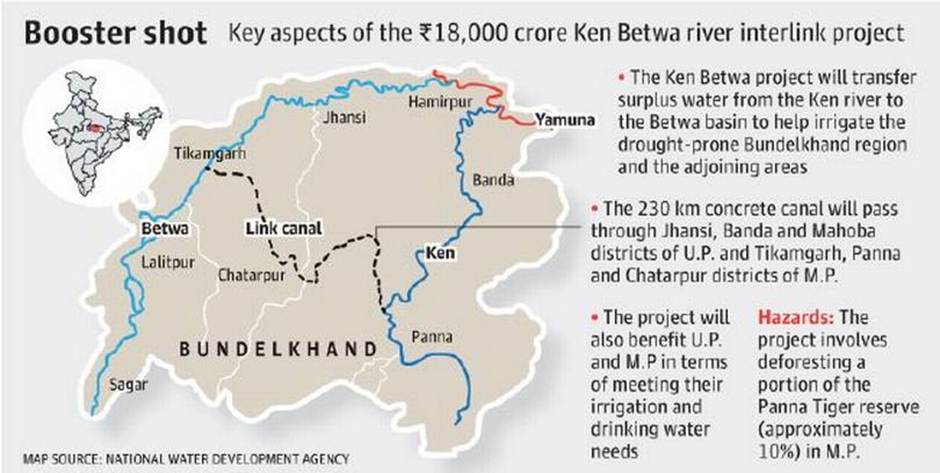
https://www.aninews.in/news/national/general-news/jal-shakti-ministry-holds-3rd-meeting-of-ken-betwa-link-project-steering-committee20230118233625/
Spot Bellied Eagle Owl - Edukemy Current Affairs
In News: Recently ‘Spot Bellied Eagle Owl’ (Bubo Nipalensis) was spotted for the first time in Seshachalam forest. It was sighted twice earlier at Nagarjunasagar Srisailam Tiger Reserve(NSTR).
About
- Primarily nocturnal, they are silver-grey, with a large yellow bill, black eyes, and sweeping sidewards-facing “horns.”
- The bold predatory bird feeds on small rodents and They are known to prey on large birds and also on mammals like golden jackals, hares, civets and chevrotains.
- The bird makes a strange scream similar to humans and it is hence called the ‘Ghost of the Forest’ in India and ‘Devil Bird’ in Sri Lanka.
Habitat: Across the Indian subcontinent, they are found in the following areas:
- Thick hill forests
- Wet lowlands
Conservation Status:
- IUCN Red List: Least Concern
- CITES: Appendix II.
Not just the hunting, trading, or any other form of utilization of owls is a punishable offense as per the provisions of the Wildlife (Protection) Act, 1972; all owl species found in India are enlisted under the CITES, which restricts their international trade.
Source:
https://www.thehindu.com/news/national/andhra-pradesh/spot-bellied-eagle-owl-spotted-in-seshachalam-forest-of-andhra-pradesh-for-the-first-time/article66396458.ece
https://ebird.org/species/sbeowl1?siteLanguage=en_IN
https://www.thehindu.com/sci-tech/energy-and-environment/an-effort-to-save-the-enigmatic-owls-in-india/article65213780.ece
Forest Advisory Committee (FAC)
In News: The Etalin hydroelectric project in Arunachal Pradesh has recently been rejected in its present form by the Forest Advisory Committee.
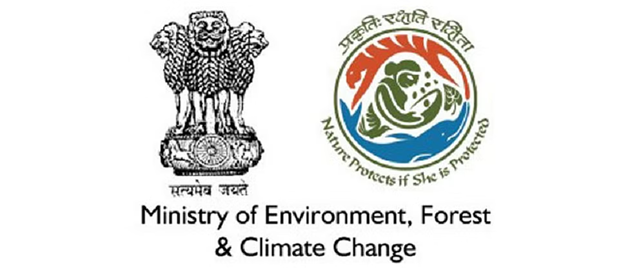
About
- Forest Conservation Act, 1980 the Central government brought Forest Conservation (Amendment) Rules 2004, section 3 and 4 of which describes the mandate of FAC.
- FAC is a statutory body headed by the Director General of Forest, MoEFCC.
- Every proposal involving more than 40 hectares of forest land, except those relating to linear projects, along with site inspection reports is referred by the Central Government to the Forest Advisory Committee (FAC).
- FAC may also suggest any condition or restrictions on the use of any forest land for any non-forest purpose.
- The Central Government, after considering the advice of the FAC grants approval to the proposal with appropriate mitigative measures or rejects the same.
- FAC’s role is advisory in nature only.
Sources:
http://moef.gov.in/wp-content/uploads/2017/08/Notificationfinal.pdf
https://www.thehindu.com/sci-tech/energy-and-environment/fac-seeks-revised-proposal-for-etalin-hydro-project-in-arunachal-pradesh/article66396079.ece
Collegium System is Law of the Land
Exam View: Judiciary, High Court and Supreme Court, NJAC, Appointment of Judges, collegium System
In News: Recently, the Supreme Court made it clear that the collegium system for appointment of judges is the law of the land and the Centre would have to follow it till it is replaced or changed. It observed that the bitter failure of the National Judicial Appointments Commission (NJAC) cannot give reasons to the government to take on the judiciary by delaying Collegium recommendations.
Constitutional politics establishes a framework of limits and the judiciary’s role in safeguarding the rights of citizens can only be ensured by keeping it insulated and independent from other organs of governance.
Constitutional politics which thrives on granting vast powers of supremacy to legislature and executive also establishes a framework of limits.
The Constitution commands that the apex court generate principles that define thresholds of power because every institution is supreme within its own domain and no institution is sovereign in India. In contrast, political competition for power must always remain invested in the decisional outcomes.
Issues Related to the Collegium System
- No Role of Executive: Judicial appointment process created a system where a few judges appoint the rest in complete secrecy.
- Issue of Nepotism and Favouritism: Does not provide any specific criteria for testing the candidate for the post of CJI which leads to wide scope for nepotism and favoritism.
- Against the Principle of Checks and Balances: Gives Judiciary immense power, which leaves little room for checks and poses the risk of misuse.
- Close-Door affairs with no public knowledge: No transparency about how and when a collegium meets, and how it takes its decisions. Also, there are no official minutes of collegium proceedings.
- Unequal Representation of women: Women are fairly underrepresented in the higher judiciary.
Way forward
- Respect for pluralism and Diversity: Small but progressive steps such as more imaginative respect for pluralism and diversity in judicial appointments is required.
- No Absolute transparency: Absolute transparency is unattainable when one must choose among many super-qualified persons.
- Procedure reasonableness: No qualified candidate should be excluded from consideration, and all must be treated equally.
- Publicly monitoring: Any symptom of non-constitutional judicial despotism should be publicly monitored and held as ground for judicial impeachment.
- Parliamentary sovereignty: Instead of Absolute parliamentary sovereignty within the law and not beyond the law is required.
Judicious comity — not confrontation — across all democratic institutions is the best response. The Constitution of India decrees and deserves deep harmony. Constitutional brinkmanship among the apex institutions of co-governance must not be allowed to menace the Amrit Kaal, and the march to the centenary of the adoption of the Constitution.
https://indianexpress.com/article/opinion/columns/collegium-system-is-law-of-the-land-idea-of-absolute-parliamentary-sovereignty-is-erroneous-8389659/
Kolam - Edukemy Current Affairs
Why in news? Recently, Tamil Nadu CM urged, to draw a kolam of ‘Tamil Nadu Vazhga’ in front of their houses to welcome the first day of Tamil month Thai.
About:
- Kolam is a form of drawing that is drawn by using rice flour, chalk, chalk powder or rock powder, often using naturally or synthetically coloured powders, in southern Indian states.
- A Kolam is a geometrical line drawing composed of curved loops, drawn around a grid pattern of dots.
- Kolams are thought to bring prosperity to homes.
- Though not as flamboyant as its other Indian contemporary, Rangoli, which is extremely colourful, a South Indian Kolam is all about symmetry, precision, and complexity.
https://www.newindianexpress.com/states/tamil-nadu/2023/jan/15/draw-tamil-nadu-vazhga-kolam-says-stalin-2538058.html
NFRA Drafts Transparency Requirements
Why in news? Recently, NFRA has published draft requirements for auditors to prepare and publish annual transparency reports to increase transparency in the management and governance of audit firms.
About:
- NFRA was constituted in 2018 under section 132(1) of Companies Act, 2013.
- It is an independent regulator to oversee the auditing profession and accounting standards with jurisdiction extending to all listed companies and large unlisted companies.
- It has the same powers as a Civil Court while trying a suit.
- It consists of a chairperson who will be appointed by the Central Government and a maximum of 15 members.
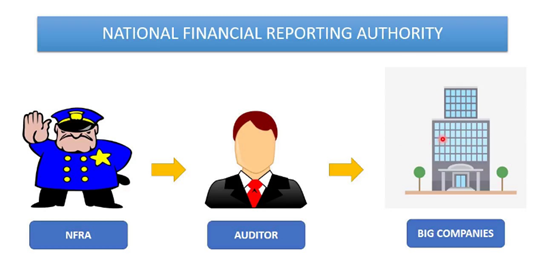
https://www.financialexpress.com/industry/regulator-releases-reporting-standards-for-audit-firms/2950297/
Grameen Udyami Scheme - Edukemy Current Affairs
Why in news? Union Minister of State for Skill Development & Entrepreneurship and Electronics & IT attended the felicitation programme of 200 tribal women under the Grameen Udyami Scheme.
About:
- Grameen Udyami Scheme was launched to augment skill training in tribal communities for their inclusive and sustainable growth.
- It is a unique multiskilling project, funded by National Skill Development Corporation (NSDC) that aims to train 450 tribal students in Madhya Pradesh and Jharkhand.
- The project is being implemented in six states— Maharashtra, Rajasthan, Chhattisgarh, Madhya Pradesh, Jharkhand, and Gujarat.

https://www.pib.gov.in/PressReleasePage.aspx?PRID=1891827
Glasgow Financial Alliance for Net Zero
Why in news? Leading financiers who pledged Net Zero are still backing fossil fuel expansion, finds the report.
About:
- It was launched in April 2021 by UN Special Envoy for Climate Action and Finance and UK Prime Minister’s Finance Adviser for COP26 in partnership with the Race to Zero campaign.
- GFANZ is a global coalition of leading financial institutions that claim to be committed to accelerating the decarbonization of the economy.
- The sectoral alliances of GFANZ have over 550 members. These financial institutions represent managed and owned assets of more than $150 trillion.
- The financial firms have pledged to report annually on the carbon emissions linked to the projects they lend to.
https://www.wionews.com/business-economy/climate-arsonists-financial-actors-invest-billions-into-fossil-fuels-despite-net-zero-pledges-says-study-553543
Advance Traffic Management System (ATMS)
Why in news? The National Highways Authority of India (NHAI) implementing advanced traffic management system to reduce accidents.

About:
- Advanced traffic management system (ATMS) involves a set of intelligently integrated roadside equipment that are connected to ensure a safe and secure journey, including smooth traffic movement and timely reaction to untoward incidents.
- The Advanced Traffic Management System will include:
- meteorological systems,
- speed detection systems,
- mobile radio communication systems including base and repeater stations, etc.
https://www.livemint.com/news/india/nhai-implementing-advance-traffic-management-system-to-reduce-accidents/amp-11673880333477.html
Yemen Capital (Sana) - Edukemy Current Affairs
Why in news? UN Yemen envoy highlighted the current absence of major fighting and its use to advance their talks toward peace.
About:
- Yemen is a desert country on the Southern tip of the Arabian Peninsula, with Red Sea and Bab-el-Mandeb on its west while the Gulf of Aden, Arabian Sea, and Guardafui Channel on the South.
- It shares its land borders with Saudi Arabia and Oman.
- It shares maritime borders with Djibouti, Eritrea and Somalia.
- It has no perennial lakes and rivers.
- Highest Point: Jabal an Nabi Shu'ayb.
https://news.un.org/en/story/2023/01/1132487
JOSHIMATH: THE SINKING LAND - Edukemy Current Affairs
Background:
Joshimath, a Himalayan town in Uttarakhand is facing a crisis of subsidence of land leading to cracks in houses and infrastructures. This has resulted in the displacement of hundreds of families in the region.
A 2019 study, The Hindu Kush Himalaya Assessment, by International Centre for Integrated Mountain Development (ICIMOD) has found tourism as a major reason for the current crisis in the Hindu-Kush Himalayan (HKH) region.
How is tourism responsible for the HKH region crisis?
The report by ICIMOD considers the burgeoning Tourism as a major reason for poorly planned or unplanned development such as
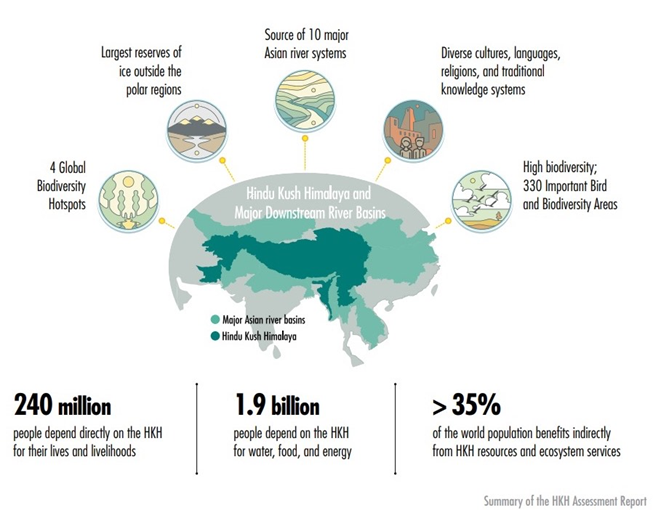
- Haphazard development of tourism infrastructure such as recreational facilities, guest houses, camping sites, and restaurants negatively impact the mountain environment significantly.
- Unbridled footprint in the ecologically sensitive area
- Inadequate solid waste management
- Air pollution due to heavy influx of tourist vehicles
- Unsustainable use of water resources as seen in Ladakh, a water deficit area, where the locals consumed 75 litres of water per day witnessed tourists consuming 100 litres per day.
What are the ethical issues involved in the Joshimath Tragedy?
- Environment versus Development debate where large hydroelectric plants are constructed jeopardising the ecological stability of the region.
- Rights of residents of the region have been affected as they are forced to migrate out of their ancestral habitat.
- Irresponsible tourist behaviour leading to over-exploitation and inequitable distribution of resources.
Source:
https://www.downtoearth.org.in/news/environment/joshimath-crisis-tourist-influx-in-himalayan-states-adding-to-ecological-burden-87171
Share the article
Get Latest Updates on Offers, Event dates, and free Mentorship sessions.

Get in touch with our Expert Academic Counsellors 👋
FAQs
UPSC Daily Current Affairs focuses on learning current events on a daily basis. An aspirant needs to study regular and updated information about current events, news, and relevant topics that are important for UPSC aspirants. It covers national and international affairs, government policies, socio-economic issues, science and technology advancements, and more.
UPSC Daily Current Affairs provides aspirants with a concise and comprehensive overview of the latest happenings and developments across various fields. It helps aspirants stay updated with current affairs and provides them with valuable insights and analysis, which are essential for answering questions in the UPSC examinations. It enhances their knowledge, analytical skills, and ability to connect current affairs with the UPSC syllabus.
UPSC Daily Current Affairs covers a wide range of topics, including politics, economics, science and technology, environment, social issues, governance, international relations, and more. It offers news summaries, in-depth analyses, editorials, opinion pieces, and relevant study materials. It also provides practice questions and quizzes to help aspirants test their understanding of current affairs.
Edukemy's UPSC Daily Current Affairs can be accessed through:
- UPSC Daily Current Affairs can be accessed through Current Affairs tab at the top of the Main Page of Edukemy.
- Edukemy Mobile app: The Daily Current Affairs can also be access through Edukemy Mobile App.
- Social media: Follow Edukemy’s official social media accounts or pages that provide UPSC Daily Current Affairs updates, including Facebook, Twitter, or Telegram channels.



